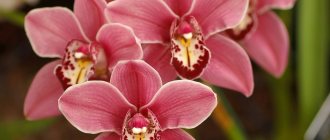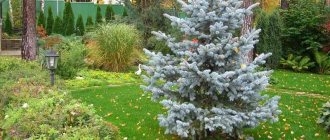5
(1)
Disputes about whether it is worth keeping an orchid in the house divide supporters and opponents into two camps, almost equal in number. Some rightly argue that there are no absolutely safe plants. For example, any substance can cause an allergy, even if it occurs very rarely. But this is not a reason to give up beautiful orchids. After all, they do not harm most people. To which opponents respond with a warning not to take risks, and invite everyone to admire orchids in botanical gardens. Arguing this by the fact that among them there are poisonous and alkaloid specimens that cause headaches.
But other indoor plants can have similar qualities. For example, cyclamen rhizomes, dieffenbachia stems, pelargonium leaves, striped scarlet, etc.
To make the right decision when purchasing an orchid, you need to know the characteristics of its type and variety. The main thing is to take into account its impact on a person.
But, in addition to the biological qualities of the orchid, some gardeners are interested in the superstitions associated with it. Everyone decides for themselves whether to believe in them or not. In our article we will talk about the scientific features of the orchid and folk signs.
Arguments in favor of orchids
Argument 1 – beauty
It is obvious that this beautiful plant is grown for its flowers of extraordinary beauty. For several decades in a row, breeders have spent a lot of time and labor to obtain new hybrids of different sizes and colors. But the main efforts are aimed at making growing at home accessible. Those who have this beauty in their home, as a rule, become fans of its beauty. It turns out that quite a few species are not only decorative, but useful.
Orchids are grown indoors for their flowers.
Reason 2 – pleasant aroma
There are many aromatic varieties. Although they differ from each other, they share common notes of sweetness and vanilla. Some have well-recognized odors:
- Calanthe stricta – orange peel,
- Pieione maculate – green apple,
- Calanthe kawakamii – lemon,
- Cymbidium rubrigemum and Rhynchostylis gigantean – spicy flower honey.
In fairness, it should be noted that in nature there are foul-smelling orchids that, for example, emit “vibes” of decomposed meat. This is Coelogyne lentiginosa.
Argument 3 – applied qualities
In nature, there is an orchid of the botanical genus Lelia, pseudobulbs which are used as food.
Since the 19th century in France, some confectioners began adding orchid petals to ice cream.
One of the most famous confectionery additives, vanilla, is obtained from the fruits of the Vanilla orchid genus, or rather, from some varieties of Vanilla planifolia. Spices for cooking and extracts for perfumes are made from them. At home it is grown where there is plenty of space. In size, it is a large climbing vine that needs powerful, high support.
The aromatic spice vanilla is obtained from the fruits of the Vanilla flatifolia orchid.
Ancient healers used the Lady's slipper orchid to prepare decoctions for migraines, heart disease, and insomnia.
This is just a small glimpse of how the orchid serves people.
Unfortunately, you can expect more than just benefits from it. Some species are poisonous. There are also those that cause allergies or can lead to headaches.
Expert advice
Orchids are very beautiful, elegant, and therefore favorite greenhouse plants. Their presence in the house became an obvious indicator of the refined taste of the owner. But is it possible to put an orchid in the bedroom? Doctors, biologists and feng shui masters give us a positive answer, but with some reservations.
Nowadays it is fashionable to decorate the bedroom with blooming orchids; their beauty fully corresponds to the atmosphere of the room.
Of course, these delicate plants require special conditions. Therefore, only certain types of them will feel as comfortable in our bedroom as we do. For example, Cattleya, Dendrobium, Phalaenopsis give us a spring mood even in the cold.
It is in vain to think that a sophisticated orchid will get used to any place in the room. Therefore, let’s get acquainted with the most useful growth conditions for her in our bedroom.
Plant health
The beauty of an orchid depends on proper care.
- The intensity of the color of the leaves indicates her well-being: too dark greens indicate a critical lack of light, their yellowness and spots (burns) signal an excess of it.
- Excess light is regulated by ordinary shading, and the deficiency is compensated by artificial lighting to induce flowering.
- The temperature that is comfortable for the plant is the same as, indeed, for us: below 30 will cause wilting, and below 15 mold will appear.
In the bedroom interior
You can add such an exotic living attribute to a modern bedroom.
- In a large room, we will place miniature pots with plants directly on the bedside tables, but only if there is sufficient ventilation, which is useful for both us and the flowers.
- In the center, the orchid will become the main and charming decoration of the interior composition. Here on a coffee table, curly cabinet or chest of drawers, surrounded by small candles or miniature decor, the plant is simply magnificent.
Advice! To emphasize the significance of a designer decoration, it is imperative to place it at eye level.
- The surroundings of the orchid are secondary, so dim souvenirs and small figurines are appropriate nearby.
- Several ecologically plastic flowers of an epiphytic species (Cambria, Cattleya) will enliven the whatnot.
- The unpretentious appearance of the semi-epiphyte on the dressing table will inspire us, and its reflection in the mirror will double the effect.
With our own hands we will create on the windowsill the effect of a greenhouse from a group of plants.
- An orchid will bloom for a long time due to the abundance of light, but the bright sun dries it out. So, let's put the beauty near the eastern or western window.
Plant selection
You can choose a plant to match the color of the interior. The instructions for florist designers name specific rules for such harmony.
The dark and rich tone of the flower will undoubtedly attract our gaze.
- a light interior will highlight the beauty of a bright plant, which certainly will not get lost here.
- if the walls are soft lilac or lavender, then let the orchid be bright pink. such a bedroom will become emphatically fashionable and stylish.
- White flowers harmoniously combine with green, blue and red backgrounds.
- purple inflorescences benefit from the azure panel.
Almost all house plants are a source of positive emotions. The orchids in the photo are no exception. In accordance with the teachings of Feng Shui, this flower is used in any room. It is only important to follow some tips for use.
- According to Chinese beliefs, orchids symbolize harmony, luxury, and elegance.
- Considering Chinese belief, this flower is often placed in the office to attract wealth.
- In the living room, this plant will create a harmonious atmosphere.
We suggest you read Holding a live fish in your hands in a dream
When choosing the color of an orchid, you should consider that:
- Snow-white and pink flowers are designed to create a peaceful environment.
- Bright flowers help cope with depressive moods.
- Dark red orchids are suitable for creative individuals. They will allow you to continue the creative process and create new masterpieces.
- For married couples, the best gift will be red orchids, which fill the space with passion, harmony and mutual trust.
How an orchid can harm
Sometimes you can hear the opinion that orchids are poisonous. Indeed, such specimens exist in nature. But those that are cultivated for growing at home, as a rule, are not. Breeders have made every effort to make them as safe as possible for humans.
However, when planning to purchase a varietal orchid, it is important to consult a specialist about possible negative effects. One of them is allergies.
Although orchid is not a typical allergen, you need to remember that there are no absolutely safe substances. Even if for most people the plant is harmless, it is possible that one person out of several thousand will not have a negative reaction.
It can be caused by orchid pollen.
T. M. Cherevchenko – Doctor of Biological Sciences, Based on the article “Orchids” from the almanac “Flowers. Indoor decorative and flowering plants."
An allergy to orchid pollen may occur in those who are prone to this disease from other flowering plants. In addition, a negative reaction can be provoked by components of the substrate:
- pine bark,
- Sphagnum moss,
- Coconut fiber or chips.
Tip #1 . If there is the slightest doubt, it is better to test for immunoglobulin and suspected allergens.
Where to keep an orchid in the house
In addition to allergies, pay attention to the aroma. The smell of a blooming orchid intensifies at night. It can cause dizziness and pain in the temples. Therefore, you should not grow the plant in the bedroom. And, especially, do not place a flower pot in the children's room . Curious kids who try everything “by tooth” may become interested in a beautiful flower and taste it.
An orchid will effectively decorate the living room. As a rule, this room is larger than others and the smell spreads more freely, so it is not too intense.
Orchid is a spectacular living room interior decor.
In some countries of the Far East, for example, in China, the orchid is considered a symbol of perfection and magic. The attitude towards this flower is ambiguous in terms of signs and superstitions.
The story of the orchid
Orchid is a flower known since ancient times. It has long been a symbol of luxury and worship. If a man presented a flower to a woman, it was a sure sign of his great sympathy and good intentions.
Since humanity has been familiar with the orchid for a long time, there are many stories and legends about it, in which it is almost always described as something that came from the gods, beauty, love or witchcraft. Thanks to such stories, we can better understand the significance of this flower in our lives.
Orchid and feng shui
Experts in ancient teachings claim that the orchid has magical properties. It is considered one of the most powerful talismans that attract positive energy. According to this theory, an orchid can be located anywhere in the house. But its influence varies depending on the zone:
| Side of the world | Effect produced |
| Southeast | Attracts active energy that increases performance. This area is best suited for an orchid in an office or study. |
| East | An orchid on this side will protect against disease and improve the health of adults, but not children. |
| Southwest | Will ensure peace and understanding between spouses. Relationships will always be passionate and sensual, without quarrels or resentments. |
| North | Attracts good luck to your career, ensures stability of income and business. |
According to Feng Shui:
- You should not place the plant in front of the front door.
- The window sill is also considered an inappropriate place.
- An undesirable neighborhood is a large amount of bulky furniture - cabinets, sideboards, cupboards, bookshelves. They interfere with the accumulation of positive energy.
- You can't put an orchid in the bedroom. It is believed that she feeds on the powers of sleeping people. For this she was nicknamed the vampire flower.
- Children feel the negative impact the most. The orchid draws positive energy onto itself. This makes children sick, capricious, and withdrawn into themselves.
Positive signs about the orchid
In addition to superstitions about the negative impact of epiphytes on humans, there are signs about orchids in the house that show them in a more rosy light.
Aura saturation
In India, there is a special attitude towards the orchid. Local residents believe that it cleanses the home of evil and drives away unkind thoughts and feelings. Keeping this flower in the house for them means maintaining a friendly family atmosphere, finding ways to mutual understanding and mutual respect between members of their family.
Impact on women
For women, keeping indoor flowers is, in principle, mandatory, and even more so orchids. This is a kind of amulet that protects health, both moral and physical, bringing inspiration, beauty, charm, femininity and other qualities necessary for every girl.
Orchid does not scare away men
By the way, there is a sign that occurred more likely due to twisting of facts than from real observations. They say that epiphytes can drive away guys, so the girl in whose house he grows risks being left alone.
All fans of orchids can calm down: this is not entirely true. As mentioned above, an epiphyte, with constant contact with a man, affects him as a woman, i.e. turns him into a pampered, perhaps even vulnerable, person, etc. But nothing more. The plant will not harm its owner, who loves and cares for it.
The right place for an orchid
It is quite logical to ask whether it is possible for married couples to keep orchids at home if the flower is not recommended for the male half, but for the female half it becomes a talisman. You can grow these beautiful flowers in every home, you just need to know where to put them.
For their location, you should avoid bedrooms, since at night the flower is especially active, like a vampire, and rooms where a man is most often.
Windows facing east or west are best. True, this is not connected with any beliefs, but with the specifics of cultivation. If you want your pet to bloom, provide it with enough sunny color. A room where the light is neither bright nor dim, but somewhat diffused, is a good choice.
For those girls who have not yet started a family, you can place epiphytes everywhere. The main thing is to look after them carefully and not ruin them, so your reverent attitude towards the plant will return to you a hundredfold.
Feng Shui about orchids
The popular eastern teaching of Feng Shui does not prohibit keeping orchids at home
Chinese sages only mention the importance of the color of a flower for one or another area of our life and its location. As for the latter, we have already mentioned, the rules of Feng Shui are the same here: the bedroom is not suitable as a permanent habitat for a flower
In addition, there are some other tips:
- plants are placed in the eastern part of the house to improve health or to recover faster when you are already sick;
- in the north - for career success;
- in the southeast - so that you can implement your plans;
- in the southwest - to light a spark in a cooled relationship;
- in the northwest - for peace in the family.
Signs and superstitions
More than once I have seen how people who consider themselves not superstitious turn back when a black cat crosses the road. Even those who do not believe in omens listen to them, just in case.
There are the following rumors about orchids:
- The flower is considered female. Next to him, a man feels insecure, becomes timid and modest. It is better to protect your companion from contact with the orchid.
- You can’t put it in the bedroom because it sucks energy.
But, in addition to the negative opinion, he is credited with a positive influence:
- Extends a woman's life span,
- Supports women's health, slows down aging, preserves beauty.
- Lifts the mood
- Banishes negative energy and fills the home with positivity,
- Protects the home from bad people. A person with evil intentions cannot cause harm.
Color signs
For a long time, color has had symbolism and a physiological effect on humans. How an orchid affects a person largely depends on the color of the flowers.
Orchids in red colors activate the body.
| Scarlet, purple, magenta, fuchsia | Activates the body: · quickens breathing, Increases blood pressure · stimulates muscle contraction. |
| Orange, Bright yellow | Improves digestion and absorption of food, as well as the functioning of all gastrointestinal organs. |
| White, pink | Stabilizes inner harmony, promoting physical balance. Helps well in depression. |
After weighing all the possible risks and positive aspects of a beautiful orchid, you can make the right decision whether to keep it at home. And if so, then put it in a place where it will be best for both you and her.
Care instructions
Some time after the plant has been restored, buds will begin to appear. A wilted peduncle should be removed after the petals have fallen. If you cut the stems too early, new ones will be able to form only after six months.
During the dormant period, the flower is placed in a warm, not very lit place. After pruning, the orchid usually rests for two months.
Orchid in a transparent pot
Required rest care:
- Don't deprive the light.
- Temperatures during the day – up to 24 degrees, at night – up to 16.
- The frequency of watering decreases. In winter you can only spray.
- In order for the buds to form, you can create a stressful situation - a temperature contrast. At night it should drop to 4-6 degrees.
- Fertilize 3-4 weeks after transplantation.
How quickly the orchid will bloom again depends on how well the care was carried out during the resting phase.
Always before starting resuscitation, it is worth studying all the methods and choosing the appropriate one. Only if the procedure is performed correctly will the flower not disappear further; on the contrary, it will be able to remain viable. Then more than once he will delight his household with beautiful blooms.











